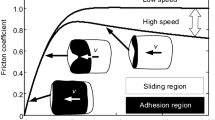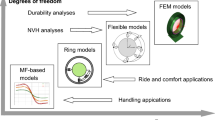Abstract
Due to inner pressure the tire is a prestressed system of cord layers. The cord layers are covered by rubber layers. The whole structure is coated by a wear-resistive thread and a soft side wall coating. Serving as a boundary condition at the cord ends is a steel ring at both sides of the wheel rim. To stiffen the thread the structure has a steel cord belt with a ply angle of ±20° to the circumferential direction. The rolling system works like a spring with changing contact forces, and to compute the car dynamics it is necessary to take into account a high frequency and nonlinear varying contact. The forces between tire and road are limited by friction which gives rise to high frequency friction oscillations. Also the structural dynamics of the tire is nonconservative and self-excited, and an appropriate damping of cords and rubber is needed to stabilize the system dynamically. The computing static equilibrium and equations of motion of a continuum mechanics membrane model are treated, and the discretization to a multi-masspoint model is shown. The resulting nonlinear system of Newtonian equations is solved by using the predictor-corrector integration method in time. The time step of integration is due to the highest frequency of the system, and it is ten times shorter than the minimum of oscillation time in the system. All the nonlinearities, the hysteretic damping, and small bending moments of the rubber layers are taken into account to compute the nonstationary rolling with slip and spin on uneven roads or soft ground.
Similar content being viewed by others
References
F. Böhm, “Computing and measurement of the handling qualities of the belted tire,” in: A. Slibar and H. Springer. The Dynamics of Vehicles on Roads and on Tracks, Proc. of 5th VSD-2nd IUTAM Symposium, Technical university Vienna, Austria, Sept. 19–23, 1977. Swets & Zeitlinger B. V. Amsterdam, 1978.
F. Böhm, Mechanik des Gürtelreifens, Ingenieur-Archiv, 35. Bd. 2. Heft, 1966, S. 82–101. Springer-Verlag, Berlin/Heidelberg/New York.
F. Böhm, Zur Statik und Dynamik des Gürtelreifens. ATZ 69 (1967) 8, Seite 255–261.
T. Tang, Geometrisch nichtlineare Berechnung von Rotations-symmetrischen, faserverstärkten Strukturen. Diss. Fortschritt-Berichte VDI, Reihe 12, Nr. 55, D 83, 1985.
K. Feng, Statische Berechnung des Gürtelreifens mit besonderer Berücksichtigung der kordverstärkten Lagen. Diss TU Berlin, Fachbereich Verkehrswesen und Angewante Mechanik, 1995.
F. Böhm, Fahreugdynamik bei Berücksichtigung elastischer und plastischer Deformationen sowie Reibung. VDI-Berichte Nr. 1007, 1992.
F. Böhm, “Action of hysteretic and frictional forces on rolling tires,” International Rubber Conference, Moscow, 26.09.–01.10.1994.
R. Wille, F. Böhm, A. Duda, and D. Zachow, Dynamisches Verhalten von Acker-schlepper-Reifen auf nachgiebigen Böden, ICIAM/GAMM 1995, Universität der Bundeswehr, Hamburg.
Additional information
Berlin Technical University, Berlin, Germany. Published in Mekhanika Kompozitnykh Materialov, Vol. 32, No. 6, pp. 824–834, November–December, 1996.
Rights and permissions
About this article
Cite this article
Böhm, F. Dynamic rolling process of tires as layered structures. Mech Compos Mater 32, 568–576 (1996). https://doi.org/10.1007/BF02280641
Received:
Issue Date:
DOI: https://doi.org/10.1007/BF02280641




